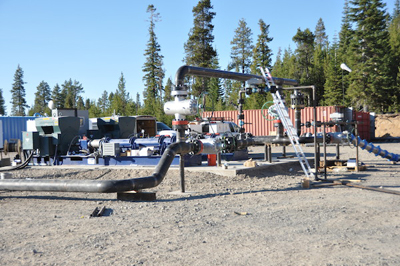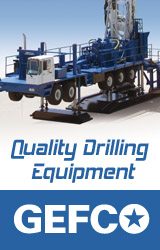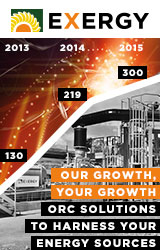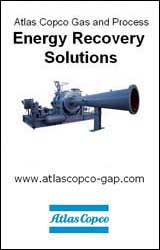Making Engineered Geothermal Systems: Ready for Primetime
 The Energy Information Administration (EIA) estimates that the demand for electricity in the United States will grow by 24% between 2011 and 2040, and that renewables will supply 16% of the electricity demand by 2040. According to the Sun Day Campaign, renewable power will actually make up a much larger percentage of America’s energy portfolio, and at a speed that’s roughly 20 years faster than EIA projects.
The Energy Information Administration (EIA) estimates that the demand for electricity in the United States will grow by 24% between 2011 and 2040, and that renewables will supply 16% of the electricity demand by 2040. According to the Sun Day Campaign, renewable power will actually make up a much larger percentage of America’s energy portfolio, and at a speed that’s roughly 20 years faster than EIA projects.
Regardless of the exact rate of growth, 50 to 77 gigawatts (GW) of coal power will be retired by 2016, and the expensive retrofits required to bring aging coal plants into compliance with clean-coal standards will force many additional plants to be retired in the coming decades.
Although deployment of variable renewable energy resources, such as solar and wind, are taking place quickly, they bring challenges to the grid in the form of voltage fluctuations and lower capacity factors. Full generation capacity is often only available 20% to 35% of the time. As technology works to improve such factors, what’s needed is a reliable, flexible, clean baseload power source that can replace retiring coal plants and meet the demand for increased electricity into the future.
Geothermal power provides unlimited, baseline power, and is driven by the heat in the earth beneath our feet. Aside from being always available, it’s also clean and safe, and new technologies are making it possible to tap into it on a large scale for the first time.
In fact, recent studies by the Massachusetts Institute of Technology (MIT), the Department of Energy, and Google conclude that there’s enough recoverable geothermal energy near the surface in the western United States to meet all of our energy needs. The problem is that most of this energy is trapped in impermeable, hot, dry rock, which requires new techniques to create enhanced or engineered geothermal systems (EGS) to convert the heat to electricity for the grid.
Creating an EGS
Conventional geothermal systems are tapped by drilling into naturally occurring hydrothermal systems in permeable rock that’s filled with hot water and/or steam. Steam and/or hot water are pumped to the surface, where it turns a turbine to generate electricity. The number of natural hydrothermal systems is finite, which has limited geothermal power to a small niche in our energy mix. Since heat is found at depth across the landscape, EGS has the potential to allow geothermal energy to quickly scale and become a major player in the global energy supply.
Three things are necessary for any geothermal system:
- Heat;
- Permeable rock; and
- Steam or water.
EGS create artificial reservoirs by using hydraulic pressure to form a network of small, hydraulically connected fractures in the rock that act as a radiator, transferring heat in the rock to water that’s circulated throughout the system. The hydraulic pressure is applied to stimulate existing cracks in the rock, so they slip and open slightly, resulting in increased permeability in the rock mass. The slip is caused by the tectonic forces that exist in the earth’s crust, and are enabled by the lubrication from the water in the opened crack. This stimulation process is called hydroshearing.
At first glance, hydroshearing appears to be similar to hydraulic fracturing (aka fracking), which is used in the oil and gas industry, but there are key differences. Hydroshearing uses moderate pressures to open very small cracks (one to two millimeters), with the goal of creating a network of thousands of permeable cracks for the efficient transfer of heat to the water.
Alternatively, fracking uses much higher pressures to initiate new tensile fractures, which propagate rapidly away from the well and result in wide fracks that require proppants to remain open. Hydrosheared cracks self-prop from the slippage and uneven surfaces on each side of the crack. Another difference is that there are no fracking fluids used in hydroshearing (just water), so the problem of ground water contamination is eliminated.
New technology
The latest development in EGS technology is multi-zonal stimulation, which is the ability to create multiple permeable zones in a single well. One way to think about this is to imagine stacking reservoirs on top of each other, such as how a high-rise building stacks office space. Just as the multiple floors in a high-rise office building allow for dramatic increases in density on a single piece of real estate, multi-zone stimulation increases the amount of rock that can be stimulated—thereby increasing the size of the reservoir and the amount of energy that can be produced from the well by a factor of three or more.
Stimulating multiple zones requires that one zone be sealed off before another zone can be stimulated. One approach is to use mechanical devices to block one zone before stimulating the second one. Another approach involves a technique using thermally degradable polymers to block successive zones. This approach reduces the risk of equipment getting stuck in the wellbore, and eliminates the cost of having a drill rig onsite during the stimulation process.
Time and the market will tell which well stimulation approach prevails, but the multi-zone approach to EGS offers the most promise for making geothermal energy a major power player.
Economic savings
Multi-zone engineered geothermal systems have been shown to lower the cost of geothermal power. Until this process was developed, however, EGS was experimental, expensive, and not commercially competitive. The problem relates to the fact that wells with a single permeable zone simply don’t produce enough hot water or steam to pay for the capital investment to drill the wells and create the system.
Increasing the flow of hot water or steam three, four, or even five times with multi-zone stimulation leverages those capital costs, and can also decrease the cost of power produced by over 50%. Put in real-world terms, a typical single-zone EGS with one injection well and two production wells might produce on the order of 1.5 megawatts (MW) of power.
Using multi-zone stimulation on the same three-well layout would result in 10 MW to 15 MW of power production. A five-acre geothermal pad could support nine directionally wells, three injectors, and six producers. In this scenario, a single-zone EGS could produce five megawatts of electricity on the five-acre pad. Multi-zone EGS would produce 30 MW to 50 MW of electricity on the same pad. The capital investment for a single-zone and multiple-zone systems is similar, so the ramifications for return-on-investment (ROI) and power generation are dramatic.
Environmental Impacts
Geothermal energy has the smallest footprint on the landscape of any energy source—conventional or renewable—by orders of magnitude because a geothermal system is underground. Considering the example of our 50 MW project on a five-acre pad, it’s worth noting that there isn’t any fuel burned to generate electricity here. No fuel delivery infrastructure is needed, and no transportation costs are incurred. With the newer, binary power plants that will be used for EGS coming online, CO2 and other emissions are close to zero, and water loss is minimized.
Concerns have been raised about EGS development causing earthquakes, disrupting aquifers, and polluting groundwater. Hydroshearing does create micro-seismic events that can only be detected by a network of precision instruments. Of course, the goal of all EGS developers is to prevent earthquakes that can be felt or that can cause damage, and this is done by studying each EGS site to determine the local magnitude threshold for felt earthquakes.
At the Newberry EGS demonstration, for example, an induced seismicity mitigation plan has been developed that requires well engineers to make proactive operational changes to keep the probability of felt events below 0.1%. If an M 2.7 event occurs, the pressure in at the well would be reduced to slow the hydroshearing, thereby reducing the fluid pressures in the rock mass and preventing a larger, felt event (M 3.5) from occurring. A microseismic array is also installed around the stimulation zone that allows engineers to closely monitor the hydroshearing process and control growth of the stimulated zone in real time.
Conclusions
The first commercial geothermal power plant came online 100 years ago at Lardarello, Italy, and is still producing power today, proving the reliability of this power source. Geothermal power is currently the greenest power source we have, and multi-zone EGS opens the possibility for broad deployment to transition a substantial portion of our energy portfolio to this reliable renewable energy source.
In addition to being a reliable baseload source, when required geothermal power can be designed, configured, and contracted for load following, spinning reserve, and supplemental reserve, making it available for flexible grid requirements. These flexible applications are increasingly needed as more variable energy resources from wind and solar come online.
Trenton Cladouhos is the senior VP of Research and Development at AltaRock Energy. He holds a BSc degree in Geology from Stanford University and a PhD in Geological Sciences from Cornell University.
AltaRock Energy
http://altarockenergy.com
Author: Trenton Cladouhos
Volume: May/June 2014











